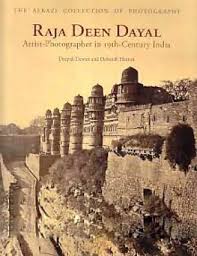
Raja Deen Dayal is the first photographer India had way back in late 19th CE, at least of that stature. From Lala Deen Dayal he went on to become Raja Deen Dayal. And also got a title of Mussavir Jung from the Nizam of Hyderabad. This book looks at his career as a photographer, his photography and its style. His celebrated albums that are important as much from the perspective of photography as the lives and times they document and his studios.
As a person, Lala Deen Dayal comes across as a passionate photographer with a shrewd blend of a businessman. Like a true entrepreneur, he went wherever he found the best opportunity. He came from a small place in UP, went on to get the best education he could get in those times. Worked with the PWD surveying the land. And from there picked up photography. Took a two-year furlough to go around India and take pictures, and never came back for the job. He opened his first studio in Indore. Followed by a bigger one in Secunderabad. And later adding another in Bombay. Photography must have been an extremely elite thing back then. So he targeted people who could afford it and nurture it.
The richest state in India then was Hyderabad with its elite class belonging to global traveling elites. And hence more in tune with new happenings. Once under the patronage of Nizam, he moved from strength to strength documenting the dominion of Nizam, his people and their lifestyle. Sitting in Hyderabad as I looked at those illustrious pictures, I wanted to go to those places and compare. Alas! A lot of them exist no more. He also introduced concepts like Zenana photography employing women photographers for the ladies behind the purdah. Though unfortunately, no public record of those photographs exist.
A chapter in the book looks at his albums. And analyses two primary types of albums. One that elite commissioned for themselves, chronicling their lives. And the others were, visit albums documenting the visits of dignitaries in the state. I love the way authors have analyzed the albums and the pictures in them. Looking at the collections and how many pictures are unique and how many re-used. What kind of pictures are shot, how the setting was done. Who were the people highlighted, how the hierarchy was maintained in the pictures. And how the reprints of albums were sold and distributed in a controlled way.
While you understand the nuances of the photography of that period which was more driven by the social norms than the technology, you also appreciate his business acumen to reuse many pictures across albums. In a way, he was also the pioneer of stock photography. When you look at the cost of those pictures and the charges he levied, you know what a big deal it was to have a picture of yours clicked by Deen Dayal & Sons.
Author’s analysis of Shikar or hunting pictures is very educative. As you learn to figure out if the picture was taken at the time of action or stage clicked later on. A popular picture of Nizam with two tigers when analyzed shows that the Tigers are stuffed. And hence the picture was taken much after the hunt. Similarly, pictures of interiors of the royal and elite residences show the places in their opulence. Something that we have to more than imagine when we visit the same places now. The elite life that was the key clientele for the firm is well documented. But like most writings on and from Hyderabad, I missed the life of an average guy in the city yet again.
You only see some servants here and there with their masters. But you get to know almost nothing about them, including the ones that worked at the Dayal Studio.
Personally, after reading this book, I am tempted to look for some of the albums mentioned in these books. And hopefully, AP State Archives would oblige. Dayal Studio, that is still operating in Secunderabad is another place I want to visit now. And again hope that Raja Saheb’s heirs will oblige.
Read it to know the things that have not and that has changed in photography since the days of Raja Deen Dayal. A bit expensive book to own, but then it is something for the collectors.








